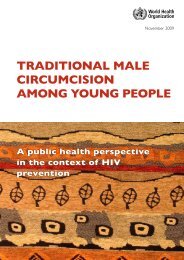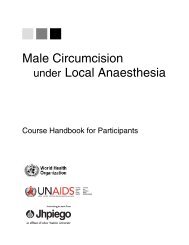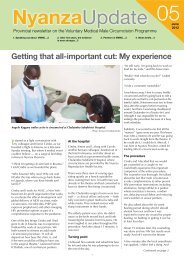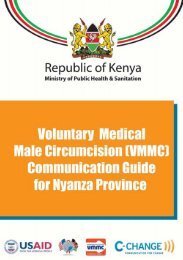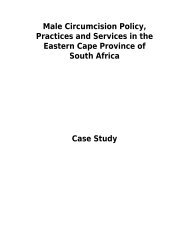August 2011 issue - Clearinghouse on Male Circumcision for HIV ...
August 2011 issue - Clearinghouse on Male Circumcision for HIV ...
August 2011 issue - Clearinghouse on Male Circumcision for HIV ...
You also want an ePaper? Increase the reach of your titles
YUMPU automatically turns print PDFs into web optimized ePapers that Google loves.
Provincial newsletter <strong>on</strong> the Voluntary Medical <strong>Male</strong> Circumcisi<strong>on</strong> Programme<br />
More benefits of male<br />
circumcisi<strong>on</strong> ............................2<br />
Clients benefit from corrective surgery<br />
Zecky Odhiambo, 21, wanted to get<br />
circumcised after he learned about the<br />
health benefits of the procedure, but <strong>on</strong>e<br />
thing held him back.<br />
“When I heard about medical male<br />
circumcisi<strong>on</strong> and that it could reduce my<br />
chances of c<strong>on</strong>tracting <strong>HIV</strong>, I always wanted<br />
to go and get circumcised,” he said. “But<br />
I had a swelling <strong>on</strong> my penis, and I was<br />
afraid to go.”<br />
Odhiambo finally put aside his fears about<br />
the c<strong>on</strong>diti<strong>on</strong> he had lived with since<br />
birth and sought voluntary medical male<br />
circumcisi<strong>on</strong> (VMMC) services. Now he<br />
is glad that he did. As a result, he was<br />
am<strong>on</strong>g 46 men who benefited from a<br />
recent surgical missi<strong>on</strong> by the Internati<strong>on</strong>al<br />
Volunteers in Urology Medicine (IVU<br />
Med), sp<strong>on</strong>sored by the World Health<br />
Organizati<strong>on</strong> (WHO), to per<strong>for</strong>m corrective<br />
surgeries <strong>for</strong> men with c<strong>on</strong>genital penile<br />
mal<strong>for</strong>mati<strong>on</strong>s.<br />
During the routine pre-operative screening<br />
<strong>for</strong> VMMC, Odhiambo had learned that he<br />
could not be circumcised until his c<strong>on</strong>diti<strong>on</strong><br />
had been treated. He could not af<strong>for</strong>d the<br />
corrective surgery, so he c<strong>on</strong>cluded that he<br />
could never be circumcised. But his VMMC<br />
counselor told him that there was hope,<br />
because surge<strong>on</strong>s were coming from the<br />
United States to per<strong>for</strong>m free surgeries to treat<br />
c<strong>on</strong>diti<strong>on</strong>s like his.<br />
Devices could trans<strong>for</strong>m delivery<br />
of male circumcisi<strong>on</strong> ..............2<br />
Dr. Hiep Nguyen, team leader, and Dr. F.A. Otieno, a surge<strong>on</strong> at Kisumu District Hospital,<br />
per<strong>for</strong>m corrective surgery during a surgical missi<strong>on</strong> to Nyanza by the Internati<strong>on</strong>al<br />
Volunteers in Urology Medicine. Photo: Silas Achar/FHI<br />
Odhiambo happily reports that he was able to<br />
obtain the corrective surgery and get circumcised<br />
during the surgical missi<strong>on</strong> at Kisumu<br />
District Hospital. “I am happy because a c<strong>on</strong>diti<strong>on</strong><br />
that made me uncom<strong>for</strong>table <strong>for</strong> l<strong>on</strong>g is<br />
now corrected and behind me,” he said.<br />
“I am even happier that I have now been<br />
circumcised as I have always wanted.”<br />
The surgical missi<strong>on</strong> was c<strong>on</strong>ducted<br />
by 12 volunteer surge<strong>on</strong>s, nurses, and<br />
anaesthetists affiliated with Harvard<br />
University’s Bost<strong>on</strong> Children’s Hospital,<br />
working in collaborati<strong>on</strong> with surge<strong>on</strong>s<br />
from Nyanza and Nairobi from 27 April to<br />
6 May. The volunteers came to Kenya in<br />
resp<strong>on</strong>se to a request <strong>for</strong> assistance from the<br />
Nyanza and nati<strong>on</strong>al task <strong>for</strong>ces <strong>on</strong> male<br />
circumcisi<strong>on</strong> through the WHO.<br />
“During screening <strong>for</strong> men who turn out<br />
<strong>for</strong> male circumcisi<strong>on</strong>, a number of them<br />
were discovered to have treatable penile<br />
c<strong>on</strong>genital mal<strong>for</strong>mati<strong>on</strong>s,” said Dr. Walter<br />
Obiero, clinical manager at the Nyanza<br />
Reproductive Health Society, who served<br />
as the nati<strong>on</strong>al and provincial task <strong>for</strong>ces’<br />
local liais<strong>on</strong> <strong>for</strong> the medical missi<strong>on</strong>.<br />
The identificati<strong>on</strong> of 200 men in need of<br />
corrective surgery and the lack of adequate<br />
capacity am<strong>on</strong>g local surge<strong>on</strong>s to per<strong>for</strong>m<br />
the corrective surgeries, Dr. Obiero<br />
explained, prompted the invitati<strong>on</strong> to<br />
internati<strong>on</strong>al volunteers. “A number of men<br />
who need these corrective surgeries can<br />
hardly af<strong>for</strong>d the cost, and it is refreshing to<br />
1<br />
04<str<strong>on</strong>g>August</str<strong>on</strong>g><br />
<str<strong>on</strong>g>2011</str<strong>on</strong>g><br />
Partners in VMMC <strong>for</strong> <strong>HIV</strong><br />
preventi<strong>on</strong> ...............................3 News briefs .............................4<br />
see WHO and IVU Med come in to help,”<br />
he added.<br />
During the missi<strong>on</strong>, surge<strong>on</strong>s from Nyanza’s<br />
Kisumu District and Aga Khan hospitals and<br />
Nairobi’s Kenyatta Nati<strong>on</strong>al, University of<br />
Nairobi, and Mbagathi hospitals were trained<br />
to per<strong>for</strong>m the surgeries, while local nurses<br />
learned how to m<strong>on</strong>itor and care <strong>for</strong> the<br />
surgical wounds.<br />
“We are hopeful that this partnership<br />
will help in building the capacity of local<br />
surge<strong>on</strong>s to carry <strong>for</strong>ward what has been<br />
started,” Dr. Obiero said.<br />
During the first medical missi<strong>on</strong>, most<br />
of the patients were treated <strong>for</strong> the most<br />
comm<strong>on</strong> <strong>for</strong>m of c<strong>on</strong>genital penile<br />
mal<strong>for</strong>mati<strong>on</strong>, known as hypospadias, in<br />
which the opening of the urethra is <strong>on</strong> the<br />
underside of the penis instead of at the tip.<br />
An IVU team will return to Nyanza in<br />
September to work with their Kenyan<br />
colleagues. They hope to reach many of the<br />
rest of the 200 men who were identified<br />
through VMMC services as needing corrective<br />
surgery.<br />
The health benefits of VMMC services are<br />
not limited to reducing men’s risk of <strong>HIV</strong><br />
infecti<strong>on</strong>. Dr. Obiero notes that the surgical<br />
missi<strong>on</strong>s, which address in part a nati<strong>on</strong>al<br />
VMMC programme goal of providing<br />
reproductive health services to men who<br />
ordinarily would not access them, are an<br />
example of <strong>on</strong>e of these additi<strong>on</strong>al benefits.<br />
“Men have reproductive health needs,<br />
but they are either too stigmatised to seek<br />
services, or they d<strong>on</strong>’t have access to<br />
those services,” he said. “Medical male<br />
circumcisi<strong>on</strong> has become an important<br />
entry point to provide men with essential<br />
reproductive health services.”<br />
These services, offered al<strong>on</strong>g with medical<br />
male circumcisi<strong>on</strong>, include voluntary <strong>HIV</strong><br />
counselling and testing, screening and<br />
treatment <strong>for</strong> sexually transmitted infecti<strong>on</strong>s,<br />
risk-reducti<strong>on</strong> counselling, and provisi<strong>on</strong> of<br />
c<strong>on</strong>doms with instructi<strong>on</strong> <strong>on</strong> their use. In<br />
the future, the government aims to link men<br />
with additi<strong>on</strong>al reproductive health services,<br />
such as family planning and management<br />
of reproductive cancers, through its VMMC<br />
programme.
More benefits of male<br />
circumcisi<strong>on</strong><br />
Dr. Jacks<strong>on</strong> Kioko<br />
welcome you to this <str<strong>on</strong>g>issue</str<strong>on</strong>g> of our<br />
I newsletter<br />
We have completed the first half of the<br />
year, and it has been eventful. The year<br />
began as we c<strong>on</strong>cluded the sec<strong>on</strong>d Rapid<br />
Results Initiative (RRI). It was a major<br />
achievement <strong>for</strong> our programme, as we<br />
surpassed our initial goal and circumcised<br />
about 50,000 men over 30 working days<br />
from November 2010 to January <str<strong>on</strong>g>2011</str<strong>on</strong>g>.<br />
Our main goal is not numbers, but impact.<br />
We are determined to fight <strong>HIV</strong> in our<br />
communities, and we have c<strong>on</strong>clusive<br />
evidence that medical male circumcisi<strong>on</strong>,<br />
together with other proven <strong>HIV</strong> preventi<strong>on</strong><br />
strategies, can reduce the number of<br />
new infecti<strong>on</strong>s. But <strong>for</strong> us to achieve the<br />
maximum impact, we must ensure that as<br />
many men as possible access voluntary<br />
medical male circumcisi<strong>on</strong> services.<br />
To achieve this goal, we c<strong>on</strong>tinue to seek<br />
more efficient ways of offering highquality<br />
services. Nyanza has led the way<br />
in c<strong>on</strong>ducting a clinical trial of male<br />
circumcisi<strong>on</strong> <strong>for</strong> <strong>HIV</strong> preventi<strong>on</strong> and in<br />
developing effective models of service<br />
delivery. Now Nyanza is privileged to<br />
participate in another important trial,<br />
which is assessing the efficacy of an adult<br />
male circumcisi<strong>on</strong> device known as the<br />
Shang Ring. Such medical devices promise<br />
to revoluti<strong>on</strong>ise the provisi<strong>on</strong> of VMMC<br />
services.<br />
Meanwhile, more than 270,000 men have<br />
sought and received VMMC services in<br />
Nyanza. As men have been coming <strong>for</strong> the<br />
services, we found that a number of them<br />
were not eligible <strong>for</strong> circumcisi<strong>on</strong> because<br />
they had c<strong>on</strong>genital penile mal<strong>for</strong>mati<strong>on</strong>s.<br />
Un<strong>for</strong>tunately, most of these men could<br />
not af<strong>for</strong>d the medical fees to undertake<br />
the corrective surgery required be<strong>for</strong>e they<br />
could be circumcised; in additi<strong>on</strong>, Kenya<br />
has few surge<strong>on</strong>s who can undertake these<br />
specialised procedures. Thus, these men<br />
might have been denied the chance to<br />
access life-changing male circumcisi<strong>on</strong><br />
services.<br />
In a bid to help the men, the Nyanza and<br />
nati<strong>on</strong>al task <strong>for</strong>ces <strong>on</strong> male circumcisi<strong>on</strong><br />
asked the World Health Organizati<strong>on</strong><br />
<strong>for</strong> assistance. This request led to a free<br />
medical camp at the Kisumu District<br />
Hospital (see page 1). Corrective surgery<br />
was per<strong>for</strong>med <strong>for</strong> 46 men who attended<br />
the camp; another camp is scheduled <strong>for</strong><br />
September. This service is <strong>on</strong>e example of<br />
the many health benefits of medical male<br />
circumcisi<strong>on</strong>.<br />
As we carry <strong>on</strong> with our ef<strong>for</strong>ts into the<br />
last half of this year, I am c<strong>on</strong>fident that<br />
we are making strides in the battle against<br />
<strong>HIV</strong>. We will c<strong>on</strong>tinue to offer highquality<br />
services to men who choose to be<br />
circumcised. I urge men to come out in<br />
large numbers to take advantage of this<br />
opportunity to protect themselves and their<br />
loved <strong>on</strong>es.<br />
Dr. Jacks<strong>on</strong> Kioko, Provincial Director of<br />
Public Health and Sanitati<strong>on</strong><br />
VMMC in Nyanza: Programme Highlights<br />
1More than 270,000 men have<br />
been circumcised in Nyanza<br />
Province since November 2008.<br />
2Nyanza’s experience has<br />
been used as a model <strong>for</strong> the<br />
expansi<strong>on</strong> of voluntary medical<br />
male circumcisi<strong>on</strong> (VMMC)<br />
services to Nairobi, Teso, and<br />
Turkana.<br />
3More than 1,620 health care<br />
providers have been trained to<br />
provide safe male circumcisi<strong>on</strong><br />
services.<br />
4Kenya became the first country<br />
to train nurses to per<strong>for</strong>m the<br />
male circumcisi<strong>on</strong> procedure in<br />
June 2009.<br />
5The 30-day Rapid Results<br />
Initiative campaigns exceeded<br />
expectati<strong>on</strong>s, reaching 36,000<br />
men and boys in 2009 and<br />
50,000 in 2010 with VMMC<br />
services.<br />
2<br />
Devices<br />
could<br />
trans<strong>for</strong>m<br />
delivery<br />
of male<br />
circumcisi<strong>on</strong><br />
Scientists in Kenya, Rwanda, and Zambia<br />
are assessing medical devices <strong>for</strong><br />
per<strong>for</strong>ming adult male circumcisi<strong>on</strong> that<br />
could revoluti<strong>on</strong>ise how the procedure<br />
is offered in areas hardest hit by the <strong>HIV</strong><br />
epidemic.<br />
Homa Bay District Hospital in Kenya’s<br />
Nyanza Province is <strong>on</strong>e of two trial sites<br />
comparing a device known as the Shang<br />
Ring with the standard male circumcisi<strong>on</strong><br />
procedure am<strong>on</strong>g 400 men; the other site<br />
is in Lusaka, Zambia. The Shang Ring has<br />
been <strong>on</strong> the market <strong>for</strong> several years in<br />
China, where over 200,000 of the devices<br />
have been used.<br />
Two Rwandan trials have evaluated a new<br />
device, known as PrePex, am<strong>on</strong>g a total<br />
of about 200 men. A third device, the<br />
Alisklamp, was evaluated in a study am<strong>on</strong>g<br />
58 men at Uasin Gishu District Hospital in<br />
Eldoret, Kenya. It has been used in Turkey,<br />
primarily with preadolescent boys, since<br />
2003.<br />
These devices, which involve no stitches and<br />
negligible bleeding, could help countries<br />
with limited health infrastructure rapidly<br />
expand access to male circumcisi<strong>on</strong> <strong>for</strong> <strong>HIV</strong><br />
preventi<strong>on</strong> by making the procedure more<br />
efficient, more acceptable to clients, and<br />
easier to per<strong>for</strong>m.<br />
All three device manufacturers are following<br />
a phased approach to studying adult male<br />
circumcisi<strong>on</strong> devices. The World Health<br />
Organizati<strong>on</strong> has called <strong>for</strong> introductory<br />
research to establish the safety, effectiveness,<br />
and acceptability of these devices in different<br />
settings be<strong>for</strong>e proceeding with more<br />
widespread implementati<strong>on</strong> in sub-Saharan<br />
Africa, and it has established an independent<br />
advisory committee to systematically<br />
review data from such studies.<br />
PrePex<br />
The PrePex system works through a special<br />
elastic mechanism, which looks like an<br />
o-ring, that fits closely around an inner<br />
ring, trapping the <strong>for</strong>eskin and cutting off its<br />
blood supply. The <strong>for</strong>eskin then dries up and<br />
is removed after a week.<br />
C<strong>on</strong>tinued <strong>on</strong> page 3
ore Core device device comp<strong>on</strong>ents<br />
The PrePex The PrePex System System<br />
The Alisklamp, PrePex, and Shang Ring adult male circumcisi<strong>on</strong> devices (shown above)<br />
The Goal The remain Goal <strong>on</strong> the penis after the procedure, like the Plastibell device that is widely used in the<br />
ALI’SKLAMP<br />
Safe, simple Safe, USA simple and <strong>for</strong> scalable ne<strong>on</strong>atal and scalable MC male in MC resource circumcisi<strong>on</strong>. in resource limited But limited settings. the Plastibell settings. falls off by itself after several days;<br />
these devices stay <strong>on</strong> l<strong>on</strong>ger, because adults heal more slowly than infants. The Shang Ring<br />
and PrePex are removed <strong>on</strong> the seventh day after surgery, and the Alisklamp is removed<br />
after five to seven days.<br />
fidential C<strong>on</strong>fidential – Circ MedTech – Circ MedTech ©2010 ©2010<br />
Devices<br />
C<strong>on</strong>tinued from page 2<br />
The PrePex procedure apparently requires no<br />
anaesthesia <strong>for</strong> most men, offering the possibility<br />
that properly trained community-based health<br />
workers might be able to use the device to<br />
per<strong>for</strong>m male circumcisi<strong>on</strong>s safely in n<strong>on</strong>-sterile<br />
settings.<br />
The results of a small safety study am<strong>on</strong>g<br />
50 men in Rwanda were promising. Study<br />
participants experienced no complicati<strong>on</strong>s<br />
during the procedure or while wearing the<br />
device. One client had some swelling after the<br />
device was removed, but that side effect was<br />
easily resolved. Afterwards, all the men were<br />
able to c<strong>on</strong>tinue their daily routines.<br />
The sec<strong>on</strong>d study, a randomised c<strong>on</strong>trolled trial,<br />
has been completed but the results are not yet<br />
published. Larger studies are needed to evaluate<br />
the PrePex device.<br />
Shang Ring<br />
The Shang Ring has an outer and inner ring.<br />
After the administrati<strong>on</strong> of local anesthesia, the<br />
inner ring is fitted at the base of the glans of the<br />
penis. The <strong>for</strong>eskin is turned inside out over the<br />
inner ring, and then the outer ring is secured<br />
over the inner ring. The two rings <strong>for</strong>m a tight<br />
seal around the <strong>for</strong>eskin, eliminating the need<br />
<strong>for</strong> sutures and preventing bleeding. Next, the<br />
<strong>for</strong>eskin is removed with sterile scissors.<br />
Results from previous studies—including two<br />
c<strong>on</strong>ducted at Homa Bay District Hospital—<br />
suggest that the Shang Ring could help<br />
dramatically reduce the time needed to per<strong>for</strong>m<br />
male circumcisi<strong>on</strong>, from about 20 or 30 minutes<br />
to 5 minutes or less. (Administering anaesthesia<br />
adds about five minutes to the time needed <strong>for</strong><br />
both types of procedures.)<br />
In a pilot study published in the 21 February<br />
<strong>on</strong>line <str<strong>on</strong>g>issue</str<strong>on</strong>g> of the Journal of Acquired Immune<br />
Deficiency Syndromes by EngenderHealth,<br />
Alisklamp<br />
ALI’SKLAMP<br />
PrePex Shang Ring<br />
Note: Temporary Note: Temporary device color. device color.<br />
5<br />
Weill Cornell Medical College, and the Kenyan<br />
Ministry of Health, all 40 participants said<br />
that they would recommend the Shang Ring<br />
procedure to others. Eighty percent of the men<br />
in this pilot study reported that they were back<br />
to work two days after the surgery. Building <strong>on</strong><br />
the promising results of the pilot study, FHI 360,<br />
EngenderHealth, and Weill Cornell Medical<br />
College are c<strong>on</strong>ducting three additi<strong>on</strong>al studies,<br />
supported by a grant to FHI 360 from the Bill &<br />
Melinda Gates Foundati<strong>on</strong>.<br />
The results of the first study, a safety study<br />
am<strong>on</strong>g 50 men completed in February, have<br />
been presented at several meetings and will be<br />
submitted to a journal. In that study all but <strong>on</strong>e<br />
of the men were back to work within two days.<br />
The sec<strong>on</strong>d study—the randomised c<strong>on</strong>trolled<br />
trial—has completed enrolment. Based <strong>on</strong><br />
preliminary data from this trial, the investigators<br />
are preparing to c<strong>on</strong>duct a larger dem<strong>on</strong>strati<strong>on</strong><br />
study involving 1,000 men in Kenya and<br />
Zambia.<br />
alisklamp<br />
The Alisklamp c<strong>on</strong>sists of a transparent<br />
polycarb<strong>on</strong>ate tube and a white plastic clamp.<br />
After local anesthesia is administered, the tube,<br />
which comes in five different sizes, is fitted<br />
between the <strong>for</strong>eskin and the penis. Then the<br />
clamp is applied over the <strong>for</strong>eskin and the<br />
surge<strong>on</strong> uses a scalpel to remove the <strong>for</strong>eskin at<br />
the base of the clamp.<br />
The study am<strong>on</strong>g 58 men in Eldoret found that<br />
the device was safe and highly acceptable.<br />
Only <strong>on</strong>e of the men experienced a side effect<br />
(temporary swelling) related to the procedure.<br />
All the study participants reported that they<br />
were able to resume routine activities after<br />
the procedure, and all said that they would<br />
recommend the Alisklamp to other men who<br />
wished to be circumcised. Additi<strong>on</strong>al studies<br />
are needed to compare the Alisklamp with other<br />
male circumcisi<strong>on</strong> procedures am<strong>on</strong>g larger<br />
groups of men.<br />
3<br />
5<br />
VMMC PaRtNeRS<br />
The following members of the Nyanza<br />
Provincial Task Force <strong>on</strong> <strong>Male</strong><br />
Circumcisi<strong>on</strong> are partners in the nati<strong>on</strong>al<br />
voluntary medical male circumcisi<strong>on</strong><br />
(VMMC) programme, which is funded<br />
by the Government of Kenya, the U.S.<br />
President’s Emergency Plan <strong>for</strong> AIDS<br />
Relief (PEPFAR), the U.S. Agency <strong>for</strong><br />
Internati<strong>on</strong>al Development (USAID), and<br />
the Bill & Melinda Gates Foundati<strong>on</strong>.<br />
Additi<strong>on</strong>al partners who collaborate<br />
with the Nyanza task <strong>for</strong>ce as part of<br />
their support to the nati<strong>on</strong>al programme<br />
include the Communicati<strong>on</strong> <strong>for</strong> Change<br />
(C-Change) Project, the United Nati<strong>on</strong>s<br />
Children’s Fund, and PSI.<br />
aPHIaPlus<br />
APHIAPlus began implementing the<br />
voluntary male circumcisi<strong>on</strong> (VMMC)<br />
programme in Nyanza in January <str<strong>on</strong>g>2011</str<strong>on</strong>g><br />
as part of a USAID-funded integrated<br />
populati<strong>on</strong> and health service delivery<br />
project in Western Kenya.<br />
The project will build the capacity of<br />
service providers, procure c<strong>on</strong>sumable<br />
supplies and equipment, support<br />
outreach programmes, provide supportive<br />
supervisi<strong>on</strong> and mentoring to providers,<br />
c<strong>on</strong>duct quality improvement activities,<br />
and create demand <strong>for</strong> VMMC and other<br />
health services in Homa Bay, Rachu<strong>on</strong>yo,<br />
and Migori districts.<br />
APHIAPlus is led by the Program <strong>for</strong><br />
Appropriate Technology in Health (PATH).<br />
Other partners are the Elizabeth Glaser<br />
Pediatric AIDS Foundati<strong>on</strong>, Jhpiego, and<br />
World Visi<strong>on</strong>. APHIAPlus succeeds the<br />
AIDS, Populati<strong>on</strong> and Health Integrated<br />
Assistance (APHIA) II Project in Nyanza.<br />
It will offer VMMC services in Nyanza till<br />
December 2015.<br />
Catholic Medical Missi<strong>on</strong> Board<br />
The Catholic Medical Missi<strong>on</strong> Board<br />
(CMMB) has set up 34 facilities<br />
that offer voluntary medical male<br />
circumcisi<strong>on</strong> (VMMC) services in Nyanza<br />
Province. CMMB staff has successfully<br />
implemented mobile services in schools,<br />
ministry of health (MOH) dispensaries,<br />
and health centres. From March 2010 to<br />
February <str<strong>on</strong>g>2011</str<strong>on</strong>g>, the CMMB reached about<br />
30,328 men with VMMC services.<br />
While implementing the VMMC<br />
programme, CMMB has learnt that<br />
creating more service delivery points and<br />
teams can help provide the services to a<br />
larger number of clients, that engagement<br />
of the public health department results<br />
in effective disseminati<strong>on</strong> of male<br />
circumcisi<strong>on</strong> in<strong>for</strong>mati<strong>on</strong>, and that<br />
community engagement can increase<br />
uptake.<br />
C<strong>on</strong>tinued <strong>on</strong> page 4
Partners in VMMC <strong>for</strong> <strong>HIV</strong> preventi<strong>on</strong><br />
C<strong>on</strong>tinued from page 3<br />
Family aIDS Care and educati<strong>on</strong><br />
Services<br />
Family AIDS Care and Educati<strong>on</strong> Services<br />
(FACES) supports comprehensive VMMC<br />
services in Suba, Migori, Nyatike, Kisumu<br />
East, and R<strong>on</strong>go at health centres and district<br />
hospitals.<br />
FACES promotes VMMC services through<br />
radio programs, public address systems, and<br />
satisfied clients. The use of incentives <strong>for</strong> those<br />
who mobilise new clients has proved effective<br />
in increasing uptake of VMMC.<br />
At all FACES sites, VMMC is discussed during<br />
health talks in both outpatient departments<br />
and c<strong>on</strong>venient care clinics. Clinical teams that<br />
disseminate accurate in<strong>for</strong>mati<strong>on</strong> have helped<br />
the programme reach out to many, especially<br />
women with <strong>HIV</strong>-negative husbands.<br />
FACES plans to upgrade two more sites in<br />
R<strong>on</strong>go and Suba as static VMMC service sites<br />
and to use its electr<strong>on</strong>ic records system to<br />
improve data management, including timely<br />
reporting.<br />
Impact Research and Development<br />
Organizati<strong>on</strong><br />
The Impact Research and Development<br />
Organizati<strong>on</strong> (IRDO) is providing VMMC<br />
services in Nyando, Kisumu East, Suba,<br />
Migori, R<strong>on</strong>go, Nyatike, Ndhiwa, and Homa<br />
Bay. It uses peer-to-peer approaches,<br />
community health workers, and community<br />
mobilisers to encourage potential clients to<br />
seek VMMC services.<br />
IRDO was the first to introduce nighttime<br />
“mo<strong>on</strong>light” VMMC services to reach those<br />
who cannot access the services during the<br />
day and the first to use female “champi<strong>on</strong>s”<br />
to help with mobilisati<strong>on</strong>. The organisati<strong>on</strong><br />
introduced these champi<strong>on</strong>s to mobilise more<br />
couples to access VMMC services together<br />
so that women can benefit from the other <strong>HIV</strong><br />
preventi<strong>on</strong> services offered al<strong>on</strong>g with male<br />
circumcisi<strong>on</strong> and so that they can understand<br />
the need <strong>for</strong> both sexual abstinence during the<br />
healing period and c<strong>on</strong>tinued practice of safe<br />
sex post-circumcisi<strong>on</strong>.<br />
<strong>Male</strong> Circumcisi<strong>on</strong> C<strong>on</strong>sortium<br />
The <strong>Male</strong> Circumcisi<strong>on</strong> C<strong>on</strong>sortium (MCC)—<br />
composed of FHI 360, EngenderHealth,<br />
and the University of Illinois at Chicago,<br />
working with the Nyanza Reproductive Health<br />
Society—has been c<strong>on</strong>ducting studies to help<br />
the Government of Kenya strengthen the<br />
implementati<strong>on</strong> of the VMMC programme. The<br />
MCC also c<strong>on</strong>tinues to support the training<br />
of health providers in safe male circumcisi<strong>on</strong><br />
and to assist in communicati<strong>on</strong>s to address<br />
misc<strong>on</strong>cepti<strong>on</strong>s about VMMC.<br />
MCC studies to asses n<strong>on</strong>physician clinicians<br />
per<strong>for</strong>ming male circumcisi<strong>on</strong>, private sector<br />
involvement in VMMC service provisi<strong>on</strong>, and<br />
outreach models <strong>for</strong> delivering VMMC services<br />
have been completed, and the findings are<br />
being disseminated.<br />
Other completed studies include <strong>on</strong>e designed<br />
to m<strong>on</strong>itor and evaluate service provisi<strong>on</strong>, as<br />
well as research <strong>on</strong> the acceptability of infant<br />
male circumcisi<strong>on</strong>, the possibility of using male<br />
circumcisi<strong>on</strong> as an entry point <strong>for</strong> male sexual<br />
and reproductive health services, and how to<br />
communicate the partial protecti<strong>on</strong> against <strong>HIV</strong><br />
offered by male circumcisi<strong>on</strong>.<br />
An <strong>on</strong>going study is assessing the impact of<br />
VMMC <strong>on</strong> <strong>HIV</strong> transmissi<strong>on</strong> and risk behaviour,<br />
clinical outcomes, and wound healing.<br />
Others are testing interventi<strong>on</strong>s to strengthen<br />
counselling and improve uptake of male<br />
circumcisi<strong>on</strong> am<strong>on</strong>g 18- to 35-year-olds.<br />
Nyanza Reproductive Health<br />
Society<br />
The Nyanza Reproductive Health Society<br />
(NRHS) has been instrumental in the<br />
expansi<strong>on</strong> of male circumcisi<strong>on</strong> services in<br />
Kenya. So far, it has expanded the VMMC<br />
programme to Nairobi, Teso, and Turkana.<br />
NRHS has teams of trainers who train health<br />
care workers in VMMC service provisi<strong>on</strong> at its<br />
Universities of Nairobi Illinois and Manitoba<br />
(UNIM) Research and Training Centre and<br />
other health facilities. Its training-of-trainers<br />
sessi<strong>on</strong>s <strong>for</strong> clinical teams take a total of five<br />
days, with the trainees participating in didactic<br />
sessi<strong>on</strong>s <strong>for</strong> three days and a practicum <strong>for</strong><br />
two days.<br />
To improve service provisi<strong>on</strong>, NRHS has<br />
introduced electrocautery machines in sites<br />
with a high volume of clients. These machines<br />
enable the clinical staff to apply an electric<br />
current to circumcisi<strong>on</strong> wounds instead of<br />
stitching them, which saves time and reduces<br />
the chances of scarring.<br />
NRHS teams spend at least six m<strong>on</strong>ths in<br />
a divisi<strong>on</strong>. This divisi<strong>on</strong>al approach helps<br />
them build relati<strong>on</strong>ships with the ministries of<br />
health staff. NRHS also plans to train partners<br />
working in other health areas to provide VMMC<br />
services.<br />
news<br />
briefs<br />
VMMC expands to Western<br />
Province and Rift Valley<br />
Free voluntary medical male<br />
circumcisi<strong>on</strong> (VMMC) services are<br />
now available in Rift Valley’s Turkana<br />
County and in four divisi<strong>on</strong>s in Teso<br />
East and West districts in Western<br />
Province. In April the ministries of<br />
health, in collaborati<strong>on</strong> with the Nyanza<br />
Reproductive Health Society, began<br />
offering a comprehensive package of<br />
VMMC and related <strong>HIV</strong> preventi<strong>on</strong><br />
services at eight facilities in four<br />
districts in Teso and at three locati<strong>on</strong>s in<br />
Turkana. Service delivery is supported<br />
by the U.S. President’s Emergency<br />
Plan <strong>for</strong> AIDS Relief (PEPFAR). The<br />
APHIAplus Project will also help<br />
provide these services in Teso and<br />
Turkana.<br />
VMMC M&e tools revised<br />
In July the voluntary medical male<br />
circumcisi<strong>on</strong> programme began using<br />
a revised <strong>for</strong>m to collect m<strong>on</strong>itoring<br />
and evaluati<strong>on</strong> data. The <strong>for</strong>m was first<br />
introduced in January 2010 <strong>on</strong> a pilot<br />
basis to enable providers throughout<br />
the programme to report uni<strong>for</strong>m data<br />
<strong>on</strong> service delivery. It has been revised<br />
based <strong>on</strong> feedback from users and the<br />
results of data quality assessments and<br />
to align it with other recently revised<br />
<strong>HIV</strong> tools. From 30 May to 8 June,<br />
the Nati<strong>on</strong>al Aids and STI C<strong>on</strong>trol<br />
Programme (NASCOP), in partnership<br />
with PEPFAR and the <strong>Male</strong> Circumcisi<strong>on</strong><br />
C<strong>on</strong>sortium, trained district Aids and STI<br />
coordinators, district health and record<br />
officers, and facility in-charges from<br />
Nyanza, Nairobi, and Rift Valley in the<br />
use of the <strong>for</strong>m.<br />
C-Change sp<strong>on</strong>sors<br />
communicati<strong>on</strong> workshop<br />
District health promoti<strong>on</strong> officers<br />
from the 13 districts implementing the<br />
voluntary medical male circumcisi<strong>on</strong><br />
programme in Nyanza were trained<br />
in effective social and behaviour<br />
change communicati<strong>on</strong> during a<br />
20-24 June workshop. The five-day<br />
training workshop was organised by the<br />
Nyanza Provincial Task Force <strong>on</strong> <strong>Male</strong><br />
Circumcisi<strong>on</strong> and sp<strong>on</strong>sored by the<br />
Communicati<strong>on</strong> <strong>for</strong> Change (C-Change)<br />
Project.<br />
The Nyanza Update is a quarterly newsletter published by the Nyanza Provincial Task Force <strong>on</strong> <strong>Male</strong> Circumcisi<strong>on</strong>.<br />
Corresp<strong>on</strong>dence sent to: Provincial Director of Public Health and Sanitati<strong>on</strong>, P.O. Box 721-40100 Kisumu. Tel.: 057 2023176/2020105<br />
pm<strong>on</strong>yanza@gmail.com; Secretary, Nyanza Provincial Task Force <strong>on</strong> <strong>Male</strong> Circumcisi<strong>on</strong>, P.O. Box 1764-40100 Kisumu. Tel. 057 2020802. ioguma@fhi360.org.





